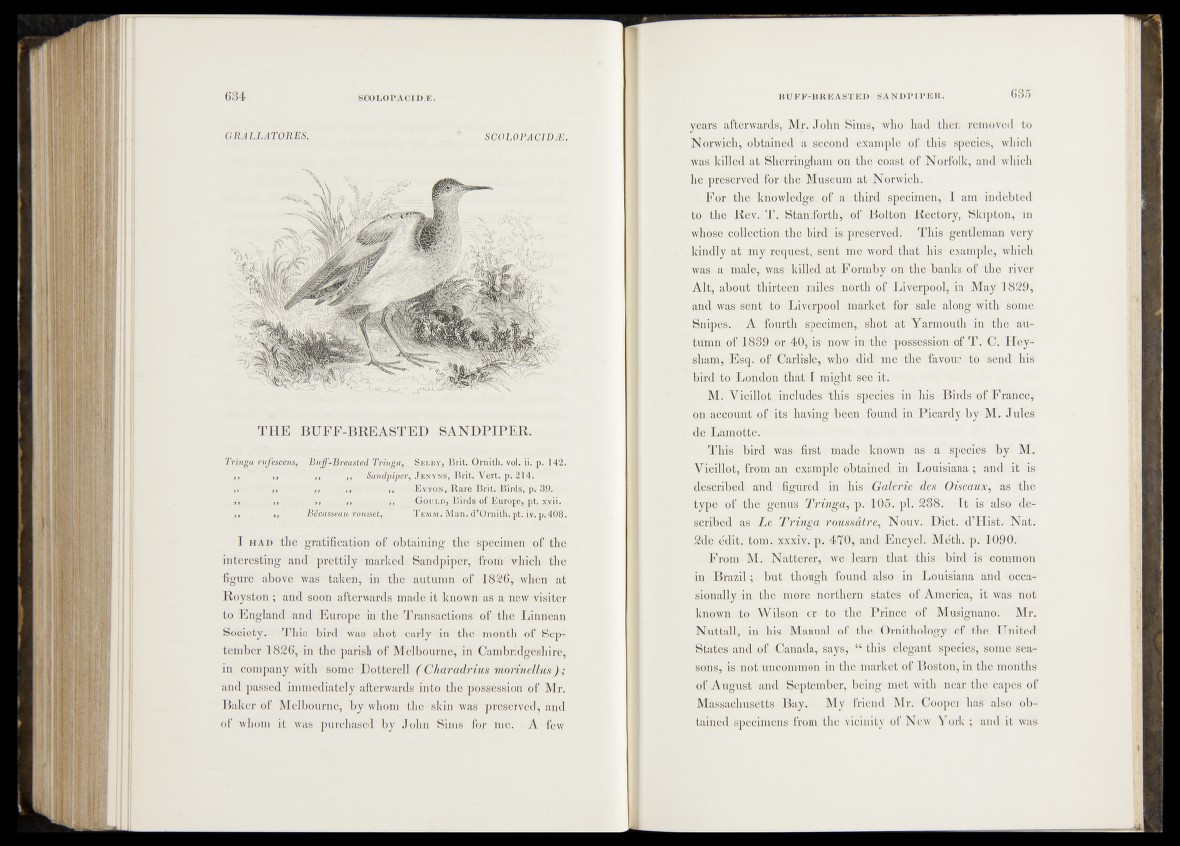
GRA LLATORES. SCOLOPACIDÆ.
TH E B U F F -B R E A ST E D SA N D P IP E R .
Tringa rufescens, Buff-Breasted Tringa, Selby, Brit. Ornith. vol. ii. p. 142.
,, i, ,, Sandpiper, J enynS, Brit. Vert. p. 214. ,, ,, >> >> ,, Eyton, Rare Brit. Birds, p. 39.
t> )> ,, ,, ,, Gould, Birds of Europe, pt. xvii.
,, ,, Bécasseau rousset, Temm, Man. d’Ornith. pt. iv. p.408.
I h a d the gratification o£ obtaining the specimen of the
interesting and prettily marked Sandpiper, from 'which the
figuré above was taken, in the autumn of 1826, when at
Royston ; and soon afterwards made it known as a new visiter
to England and Europe in the Transactions of the Linnean
Society. This bird was shot early in the month of September
1826, in the parish of Melbourne, in Cambridgeshire,
in company with some Dotterell ( Charadrius morinellus) ;
and passed immediately afterwards into the possession of Mr.
Baker of Melbourne, by whom the skin was preserved, and
of whom it was purchased by John Sims for me. • A few
years afterwards, Mr. John Sims, who had then removed to
Norwich* obtained a second example of this species, which
was killed at Sherringham on the coast of Norfolk, and which
he preserved for the Museum at Norwich.
For the knowledge of a third specimen, I am indebted
to the Rev. T. Staniforth, of Bolton Rectory, Skipton, in
whose collection the bird is preserved. This gentleman very
kindly at my request, sent me' word that his example, which
was a male, was killed at Formby on the banks of the river
Alt, about thirteen miles north of Liverpool, in May 1829,
and was sent to Liverpool • market for sale along with some
Snipes. A fourth specimen, shot at Yarmouth in the autumn
of 1839 or 40, is now in thé possession of T. C. Hey-
sham, Esq. of Carlisle, who did me the favour to send his
bird to London that I might see it.
M. Vieillot includes this species in his Birds of France,
on account of its having been found in Picardy by M. Jules
de Lamotte.
This bird was first made • known as a species by M.
Vieillot,drom an example obtained in Louisiana; and it is
described and figured in his Galerie des Oiseaux, as the
type of the genus T r in g a , p. 105. pi. 238. It is also described
as Le T ringa roussâtre, Nouv. Diet. d’Hist. Nat.
2de édit. tom. xxxiv. p. 470, and Encycl. Méth. p. 1090.
From M. Natterer, we learn that this bird is common
in Brazil ; but though found also in Louisiana and occasionally
in the more northern states of America, it was not
known to Wilson or to the Prince of Musignano. Mn
Nuttàll, in his Manual of the Ornithology of .the United
States and of Canada, says, “ this elegant species, some seasons,
is not uncommon in the market of Boston, in the months
of August and September, being met with near the capes of
Massachusetts Bay. My friend Mr. Cooper has also obtained
specimens from the vicinity of New York ; and it was